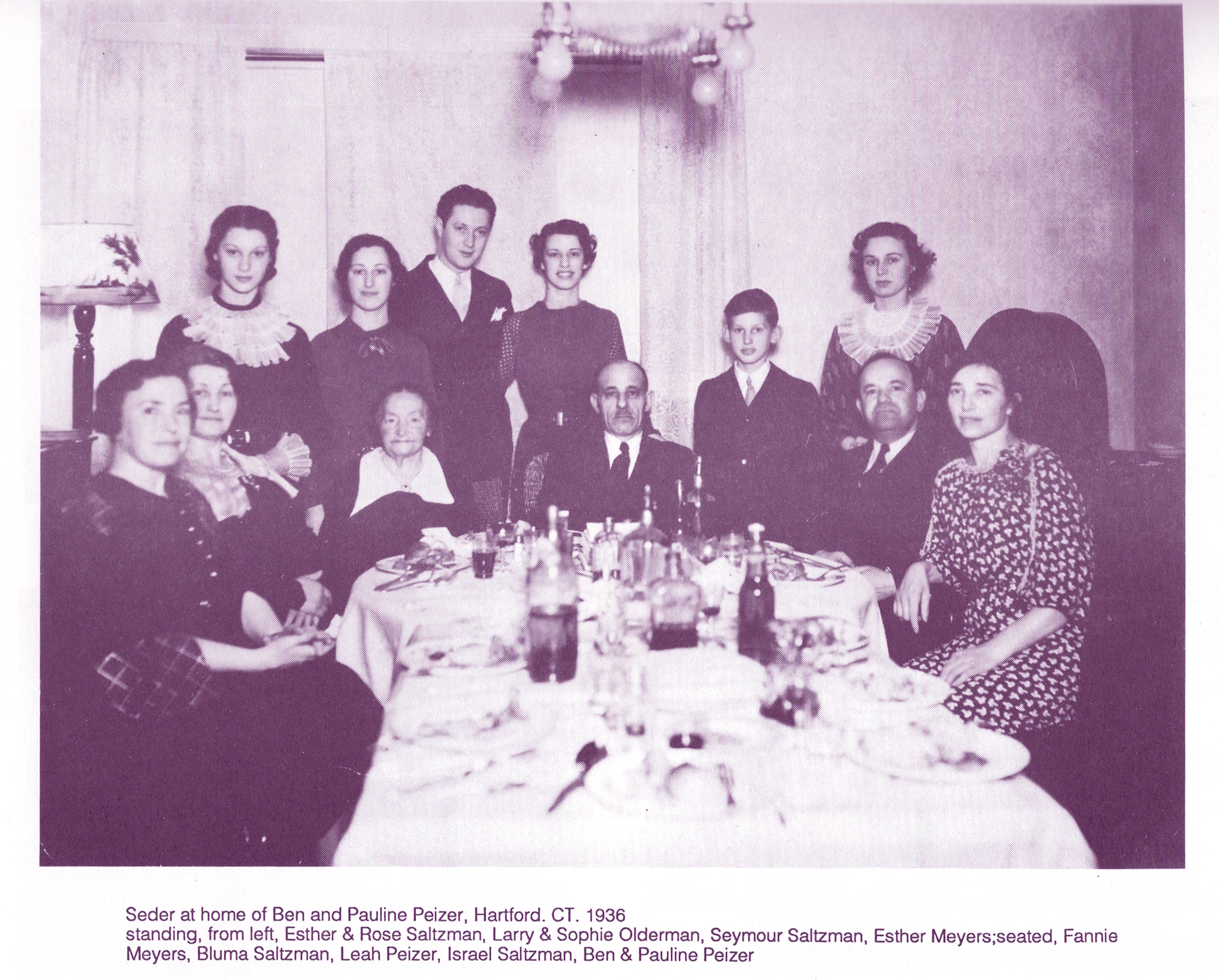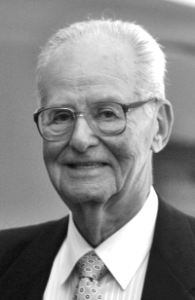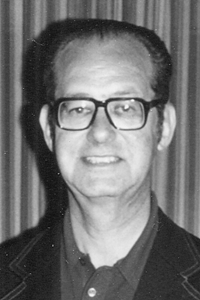Seymour’s Early Years
The Story of Seymour Saltzman – as told to Robert Saltzman
January 2012
Seymour was born at Hartford Hospital on October 17, 1923, the fifth child of Bluma and Israel Saltzman. Seymour had a much older brother Abe (“Duke”), and three older sisters, Rose, Sophie and Esther. In the early years of his life the family lived on the second floor of a three-family house that they owned at 43 Blue Hills Avenue in Hartford.
One of Seymour’s earliest recollections is of a man, a World War I veteran, who lived upstairs and often came home drunk at night, singing as he climbed the stairs. In the back yard there was a chicken coop which regularly supplied the family with fresh eggs. Occasionally, a chicken was taken to Rome’s Chicken Market for slaughter.
At some point in the Depression, the family house on Blue Hills Avenue was foreclosed upon and lost. The family eventually recovered and bought a nearby two-family house on Milford Street in Hartford, where they lived for two or three years. Then the family moved to another two-family house at 47-49 Manchester Street in Hartford.
Seymour attended Northwest Elementary School through the 6th grade; Jones Junior high for grades 7-9; and Weaver High School for grades 10-12. He was a good student who made the Honor Roll at Weaver HS, graduating in 1941. He did well in math and seemed to enjoy taking Latin for four years. As graduation approached, Seymour considered attending college at either the University of Connecticut or at Trinity College. The former had low tuition but would require him to live in Storrs, while the latter had high tuition but would allow him to live at home.
Wesleyan, in Middletown, CT, was not under consideration initially because it was too expensive (about $450 per year) and, being about 20 miles from Hartford, too far to commute to from home. However, during his senior year of high school, Seymour applied for a Jacob Fox Foundation Scholarship — awardees received $400 per year for two years. He was the only person from Weaver to win a Fox Scholarship that year (along with three students from Hartford Public and one from Bulkeley). As a result, Lewis Fox suggested that he apply to Wesleyan, which he did. Upon getting accepted, Seymour was also offered a “standard scholarship” of $300 by Wesleyan, making it feasible for him to attend Wesleyan. Seymour met a fellow Fox Scholar from HPHS named John Antoinetti who was also planning to attend Wesleyan, and they became freshman roommates.
In the fall of 1941, Wesleyan had a total of only about 450 students, all male. In Seymour’s freshman year, he lived on campus in Foss House, an old structure that housed about a dozen men. In addition to John Antoinetti, Seymour had another buddy in the house named John “Jigs” Gigante. Seymour studied with the intent of becoming a high school or junior high school math teacher, and started out taking courses in Math, English, Biology, and perhaps Social Studies. Everything would change, however, after Pearl Harbor was attacked by the Japanese and the U.S. entered the war on December 8, 1941.
In Seymour’s sophomore year, students were urged to sign up for the Enlisted Reserve Corps (an organization of the Aviation section of the U.S. Army Signal Corps), with the promise that they would be able to finish college before being called into service. After taking a brief second eye test in Hartford (he failed the first in Middletown), Seymour was accepted into the Enlisted Reserve Corps. However, after the Fall 1942 semester, those who had enlisted were told not to return to Wesleyan for the Spring 1943 semester because they would, in fact, be getting called into service.
Seymour was called up to Fort Devins in Ayer, MA (between Springfield and Boston) on March 22, 1943. He spent about four days there, and was then sent on a train to Atlantic City, NJ for basic training. The meandering train went to all sorts of cities and towns picking up soldiers. Surprisingly, Seymour was housed for about six weeks in the Ritz-Carlton Hotel near the boardwalk, sharing a room with a number of other men. There they learned to shoot, marched and sang on the boardwalk, heard lectures, performed work details, and took exams. The Army took advantage of Atlantic City due to its capacity to house so many soldiers quickly and its spacious convention center. One memorable event from this period was spending Passover with a local family, arranged by the Army for Jewish soldiers.
After his placement exam, Seymour was sent down to Baton Rouge, LA for another two months of training as a clerk during May and June 1943. He lived in a dorm built into the stadium of Louisiana State University. There were perhaps 300-400 trainees in the Army Administration School. Among other things, they learned to type in college classrooms; no shooting was involved here. It was quite hot. The highlight of this period was a weekend trip to New Orleans, where he walked around the French Quarter and swam in Lake Pontchartrain. While there, Seymour was startled to run into a friend from Hartford, Stanley Kaufman.
From Baton Rouge, Seymour was ordered to southern California. Getting there on a train took about two or three days. It was very hot, with just a few stops along the way. Ultimately, they reached a camp outside of San Bernardino, CA where Seymour was assigned to the 52nd Medical Supply Platoon. Here, he met his future comrades: two officers (a first and a second lieutenant) and about 20 enlisted men. This platoon was part of a larger Air Services Group comprised of mechanics, pilots, medical suppliers, etc. He spent about a month there for the last phase of his training. He recalls going on marches in the hills of San Bernardino, which was surrounded by desert.
The last few days in California were spent in Camp Anza, a staging area in Riverside for troops headed overseas. Around September 7, 1943, Seymour’s platoon shipped out from the port of Los Angeles. The ship took about three weeks to reach Hobart, Tasmania (a British colony at the time), where they had three days of shore leave. While in Hobart, the soldiers were allowed to walk around town, but only in formation. After three more weeks of travel, the ship reached Bombay on the western side of India. Some soldiers got off here, but Seymour and about 1500 others were put on a British ship (The Nevasa) and sent around the southern tip of India. After a stop in Ceylon (Sri Lanka), they travelled up the east side of India, reaching Calcutta 12 days after departing Bombay. Trucks took them another 15 miles from Calcutta’s docks to an Army camp where he would be based from November 1943 until January 1945.
The first few days were spent getting oriented and introduced to where they’d work – a converted jute plant that consisted of three or four adjacent buildings. Perhaps a quarter of the plant was used as an office, and the rest was used to store large quantities of supplies. The depot served as the central medical supplier for all Air Force units operating in India, Burma and China. Incoming materiel was shipped to Calcutta and then trucked to the depot. Items were identified by number, and manually stored and picked.
Orders for various items came in on requisition forms. Seymour worked in the front office and had to check if the requested quantities were reasonable for the size of the unit requesting them; and if so, did the depot have enough on hand to fulfill the orders. Occasionally, order quantities were reduced. As supplies were shipped out, they had to keep track of the remaining amounts on hand. Orders were packed up in wooden boxes for shipment via train and plane. One of the more controversial items stocked was whiskey: each successful flight by a pilot earned him the right to obtain two ounces of whiskey!
Soldiers generally had at least one day off per week, so Seymour went into Calcutta about once a week for a meal and possibly some shopping. After a year of service, soldiers were given a two-week rest leave at a “rest camp” for enlisted men located 300-400 miles north of Calcutta near the Himalayan city of Darjeeling, at an elevation of over 6,000 feet. The camp was about an hour’s walk up from Darjeeling. While Seymour was there on his rest leave, he read in a newspaper that a big fire had broken out at the Ringling Brothers and Barnum & Bailey Circus held in Hartford, CT. A few weeks later, in a letter from his sister Esther Handler, Seymour learned that Esther’s husband Moe and Seymour’s nephews Phil Handler and Steven Olderman had been at the circus that day but managed to escape unharmed.
In January 1945, the 52nd Medical Supply Platoon was sent to Burma, northeast of Calcutta. The mission here was similar to that in Calcutta, but carried out on a smaller scale by just one platoon. The new depot was isolated, and located near Myitkyina, a city that the Japanese had nearly destroyed. Materiel came in by plane from India and was stored in tents. Orders went out mostly by truck, but the volume was lower than in India.
In September 1945, the war ended; in November or December, Seymour’s platoon was sent home on a ship that travelled west through the Arabian Sea, the Suez Canal, the Mediterranean Sea and the Atlantic Ocean. Ultimately, they landed in New York City on New Year’s Day 1946. They were immediately ferried over to New Jersey and then trucked to an army camp. After two days there, Seymour was sent back to Fort Devins in Ayer, MA, where he was discharged from the Army. He took a train back to Hartford.
After being away for three years, Seymour returned to Wesleyan for the Spring 1946 semester. He was able to get a room and enroll in a full schedule of classes. While John Antoinetti had come back to Wesleyan, John Gigante had transferred to West Point. An important event of this semester was a visit made in late spring by Sophie, Esther and Duke. They drove down to Middletown one night to encourage Seymour to consider making a career in medicine instead of teaching. After thinking it over Seymour decided to give it a try by taking pre-med courses, including some during the summer of 1946. In 1947, Seymour applied to medical schools and was accepted at Syracuse University.
Seymour began his medical studies at Syracuse in the Fall of 1947 without having finished his degree at Wesleyan. Fortunately, Wesleyan decided that courses taken at Syracuse could be counted toward his undergraduate degree. In June 1948, Seymour not only received his bachelor’s degree from Wesleyan, he also was elected to Phi Beta Kappa. This surprising news came to him in a phone call from Professor Arnold on the day after he had returned to Hartford from Syracuse.
At some point during medical school, Seymour began his courtship of Bernice Meyer, a Syracuse undergraduate from Richmond, VA. Ultimately, they decided to get married in Syracuse on the same day that Seymour would graduate from medical school (June 4, 1951) in order to make it as easy as possible for his elderly parents to attend both events. The wedding was held at a synagogue (Temple Concord) followed by a dinner party at Bernice’s Aunt Sylvia (Radman) and Uncle Joe Kallet’s home in Syracuse.




